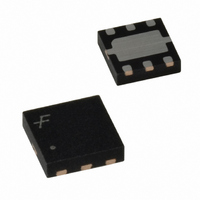FPF2147 Fairchild Semiconductor, FPF2147 Datasheet - Page 9

FPF2147
Manufacturer Part Number
FPF2147
Description
IC LOAD SWITCH REV CURR BK 6-MLP
Manufacturer
Fairchild Semiconductor
Type
High Side Switchr
Datasheet
1.FPF2146.pdf
(13 pages)
Specifications of FPF2147
Number Of Outputs
1
Rds (on)
160 mOhm
Internal Switch(s)
Yes
Current Limit
400mA
Voltage - Input
1.8 ~ 5.5 V
Operating Temperature
-40°C ~ 85°C
Mounting Type
Surface Mount
Package / Case
6-MLP
Lead Free Status / RoHS Status
Lead free / RoHS Compliant
Other names
FPF2147TR
FPF2140/42/43/44/46/47 Rev. D
Description of Operation
The FPF2140/42/43/44/46/47 are current limited switches that
protect systems and loads which can be damaged or disrupted
by the application of high currents. The core of each device is a
0.12Ω P-channel MOSFET and a controller capable of
functioning over a wide input operating range of 1.8-5.5V. The
controller protects against system malfunctions through current
limiting, undervoltage lockout and thermal shutdown. The
current limit is preset for either 200mA or 400mA.
On/Off Control
The ON pin controls the state of the switch. Activating ON
continuously holds the switch in the on state so long as there is
no undervoltage on V
140°C. ON is active HI and has a low threshold making it
capable of interfacing with low voltage signals. In addition,
excessive currents will cause the switch to turn off for FPF2140/
42 and FPF2144/46. The FPF2140/44 have an
feature which will automatically turn the switch on again after
450ms. For the FPF2142/46, the ON pin must be toggled to
turn-on the switch again. With no auto-restart, the FPF2143/47
do not turn off in response to a over current condition but
instead remain operating in a constant current mode so long as
ON is active and the thermal shutdown or undervoltage lockout
have not activated.
Fault Reporting
Upon the detection of an over-current, an input undervoltage, or
an over-temperature condition, the FLAGB signals the fault
mode by activating LO. For the FPF2140/42/44/46, the FLAGB
goes LO at the end of the blanking time while FLAGB goes LO
immediately for the FPF2143/47. FLAGB remains LO through
the Auto-Restart Time for the FPF2140/44. For the FPF2142/
46, FLAGB is latched LO and ON must be toggled to release it.
With the FPF2143/47, FLAGB is LO during the faults and
immediately returns HI at the end of the fault condition. FLAGB
is an open-drain MOSFET which requires a pull-up resistor
between V
FLAGB is disabled to reduce current draw from the supply.
Current Limiting
The current limit guarantees that the current through the switch
doesn't exceed a maximum value while not limiting at less than
a minimum value. For the FPF2140/42/43 the minimum current
is 200mA and the maximum current is 400mA and for the
FPF2144/46/47 the minimum current is 400mA and the
maximum current is 800mA. The FPF2140/42/44/46 have a
blanking time of 30ms, nominally, during which the switch will
act as a constant current source. At the end of the blanking
time, the switch will be turned-off and the FLAGB pin will
activate to indicate that current limiting has occurred. The
FPF2143/47 have no current limit blanking period so
immediately upon a current limit condition FLAGB is activated.
These parts will remain in a constant current state until the ON
pin is deactivated or the thermal shutdown turns-off the switch.
IN
and FLAGB. During shutdown, the pull-down on
IN
or a junction temperature in excess of
Auto-Restart
9
For preventing the switch from large power dissipation during
heavy load a short circuit detection feature is introduced. Short
circuit condition is detected by observing the output voltage.
The switch is put into short circuit current limiting mode if the
switch is loaded with a heavy load. When the output voltage
drops below VSCTH, short circuit detection threshold voltage,
the current limit value re-conditioned and short circuit current
limit value is decreased to 62.5% of the current limit value. This
keeps the power dissipation of the part below a certain limit
even at dead short conditions at 5.5V input voltage. The VSCTH
value is set to be 1V. At around 1.1V of output voltage the
switch is removed from short circuit current limiting mode and
the current limit is set to the current limit value.
Undervoltage Lockout
The undervoltage lockout turns-off the switch if the input
voltage drops below the undervoltage lockout threshold. With
the ON pin active the input voltage rising above the
undervoltage lockout threshold will cause a controlled turn-on of
the switch which limits current over-shoots.
Reverse Current Blocking
The entire FPF2140/47 family has a Reverse Current Blocking
feature that protects input source against current flow from
output to input. For a standard USB power design, this is an
important feature which protects the USB host from being
damaged due to reverse current flow on V
current blocking feature is active when the load switch is turned
off.
If ON pin is LO and output voltage become greater than input
voltage, no current can flow from the output to the input . The
FLAGB operation is independent of the Reverse Current
blocking feature and will not report a fault condition if this
feature is activated.
Thermal Shutdown
The thermal shutdown protects the die from internally or
externally generated excessive temperatures. During an
over-temperature condition the FLAGB is activated and the
switch is turned-off. The switch automatically turns-on again if
temperature of the die drops below the threshold temperature.
BUS
www.fairchildsemi.com
. The reverse











